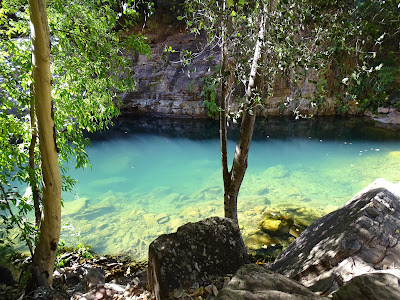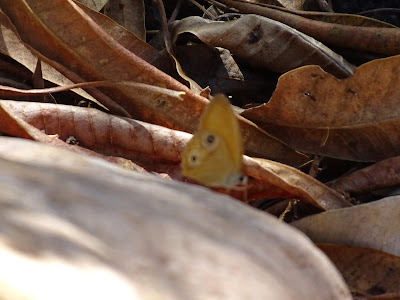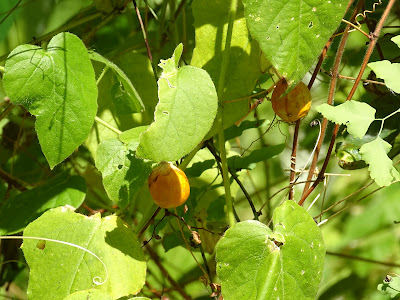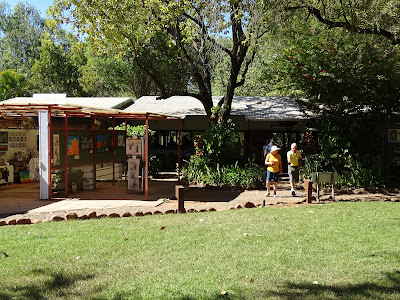Day Seven: Tuesday, 11th May 2021
Woke early and strolled around the campsite to enjoy the sunrise, the bird calls, and the serenity!
Part of the Cockburn Ranges at sunrise from Emma Gorge Resort
Spiral Pandanus (Pandanus spiralis)
Spiral pandanus is native to northern Australia, occurring in Queensland, Northern NSW, The Northern Territory, and the extreme north of Western Australia.. It is commonly called common screwpine, iidool, pandanus palm, screw pine, screw palm, or spring pandanus. It is neither a true palm, nor a pine, but is a shrub or small tree up to 10 metres in height. It has long, spiny leaves organised in a spiral arrangement, and a large, pineapple-like cluster of fruit that turn orange-red when ripe. Wildlife, including birds, take advantage of the spiny leaves by living in the tree for protection. They also favor its fruit. The plant is most commonly found growing along watercourses or coastal fringes and dune systems.
Tawny Coster (Acraea terpsicore)
The tawny coster, is a small, 53–64 millimetres, leathery-winged butterfly that is common in grassland and scrub habitats. Originally from India, it is a recent arrival in northern Australia.
The adult flies slowly with weak seemingly unsteady wing beats. It is one of the boldest butterflies, protected as it is from predators by a nauseous chemical. When attacked it plays dead and exudes a noxious yellowish fluid from glands in the joints of the legs. Like all butterflies protected in this manner, it has a tough exoskeleton which enables the adult to survive a few pecks of a bird, or even the bites of a lizard. Once left alone the adult immediately takes off and resumes its uncaring flight.
When feeding on flowers, this butterfly is unhurried, often spending a long time sitting on the same flower. When sitting it either spreads its wings or closes them over its back the hindwings covering the forewings to a large extent. Sometimes the butterfly will not sit, but rest gently on the flower while feeding, while doing this, to maintain balance, it beats only its forewings while keeping the hindwings completely steady.
Ripple patterns on the rocks were created when sediment was deposited under shallow tidal waters millions of years ago.
It was quite hot walking along the gorge, and the shade provided a welcome respite. From Left: Julie; Helen W; Greg (taking photo); Karen (standing); Pier; Leon; Dave.
Then we entered a different section where the vegetation changed dramatically from savanna woodland to remnant rainforest. It was also much cooler, with the gorge cliff faces narrowing.
Sadly, all the ferns in this locality were destroyed and washed away during the 2005 cyclone.
The Bush Passionfruit (also known as: stinking passionflower, wild maracuja, bush passion fruit, wild water lemon, stoneflower, love-in-a-mist, or, running pop) is a species of passion flower that is native to the southwestern United States, Mexico, the Caribbean, Central America, and much of South America. It was introduced to Australia in the 1880s. It is a creeping vine like other members of the genus, and yields an edible fruit. The second part of its scientific name - foetida - means "stinking" in Latin and refers to the strong aroma emitted by damaged foliage.
So, we passed on from out visit to Emma Gorge and Falls, yet again in awe at the wonder of Nature's patience. This place is starting to give us a new understanding of time!
After crossing the ford, we enjoyed some respite from the road, and enjoyed more, though different, beautiful things.
And, so on Home Valley Station, where we settled into our room, then took a quick swim in the pool. Power at the Station was off, so no running water, air-conditioning, lights, hot drink, etc. Never mind, we embussed and drove to a site overlooking the Pentecost River and the Cockburn Ranges to enjoy drinks while the sun set.
When feeding on flowers, this butterfly is unhurried, often spending a long time sitting on the same flower. When sitting it either spreads its wings or closes them over its back the hindwings covering the forewings to a large extent. Sometimes the butterfly will not sit, but rest gently on the flower while feeding, while doing this, to maintain balance, it beats only its forewings while keeping the hindwings completely steady.
We made an early start walking through grasslands and a small patch of swamp bloodwoods, with Emma Creek down to our left.
The Emma Gorge walk offers a unique trek through the Cockburn Range. The scenic trail leads through changing vegetation to crystal-clear pools.
The gorge is characterised by massive scree slopes and cliff face escarpments up to 120 metres high on
both sides.
Ripple patterns
Ripple patterns
Ripple patterns
Ripple patterns
Ripple patterns
Ripple patterns
About halfway along to our destination, is Flagstaff Falls - unfortunately dry for our visit.
Flagstaff Falls, Emma Gorge
During heavy rain, the falls turn into a raging torrent, plunging down the sheer 112 metre cliff face.
Steph (white cap), and Helen F (pink hat)
The trail gradually became more rugged, and we needed to use both arms and legs to negotiate our way, and to schedule regular rest breaks.
From left: Leon; Helen F; Noreen; Colleen; Brian Mc; Karen; Angela - taking a break before moving on the the Fern Pool.
Archerfish in the Fern Pool
The Turquoise Pool
The Turquoise Pool
And then we could relish our reward - Emma Gorge and Falls. A swim, a snack, and then the return trail.
Emma Gorge and Falls
Emma Gorge and Falls
Emma Gorge and Falls
Colleen, Helen F, & Pier at Emma Gorge and Falls
Helen & Anthony at Emma Gorge and Falls
Greg & Colleen at Emma Gorge and Falls
Brian O at Emma Gorge and Falls
On the return hike, I pondered a lot on the randomness of nature's course, and, on how inanimate things can evoke powerful emotions. The appreciation of beauty may be subjective, but it may also be intrinsic, though transient.
A water-carrying section of Emma Creek
A rock pool in Emma Creek
A lovely little butterfly
Another Scarlet Lurcher near Emma Creek
Pandanus, eucalypt, red cliffs, and Brian O
A puddle on Emma Creek
And, another rockpool on Emma Creek
Bush Passionfruit
Bush Passionfruit (Passiflora foetida)
There is someone hiding behind the tree!
Mini waterfall on Emma Creek
Lunch at Champagne Springs Station
Champagne Springs Station
Champagne Springs Station
We departed El Questro's Emma Gorge Lodge, and drove to El Questro's Champagne Springs Station for lunch.
Cockburn Ranges from the Gibb River Road
Still on the rough Gibb River Road, and with the Cockburn Ranges to the north, we drove on towards Home Valley Station, or destination for the evening.
Gibb River Road at the Pentecost River crossing with Cockburn Ranges in the distance
By the side of the Pentecost River near the ford
Part of the beautiful Cockburn Ranges
Karen; & Sue at the rest area near the Pentecost River ford
Dried Batchelor's Buttons, near the Pentecost River ford
Table and seats at the rest area near the Pentecost River ford
Home Valley Station
Boab, Home Valley Station
Dining and entertainment complex, Home Valley Station
Pool and recreation area, Home Valley Station
Accommodation, Home Valley Station
Australian Hornet (Abispa ephippium)
Pentecost River and Cockburn Ranges
Bank of the Pentecost River
The Sundowners!
From the left: Sue; Karen (obscured); Kaylene; Dave; Joanne; Helen W; Pier; Chris; Carol; Angela; Colleen (in red); Greg (back to camera); Brian O; Noreen; Brian Mc; Leon; Helen F.
Saltwater Crocodile (Crocodylus porosus)
It was satisfying to finally make this first, though distant, sighting of a saltwater crocodile. Some believed it was quite close enough!!
The saltwater crocodile is native to saltwater habitats and brackish wetlands from India's east coast across Southeast Asia to northern Australia and Micronesia. It was hunted for its skin throughout its range up to the 1970s, and is still threatened by illegal killing and habitat loss.
The saltwater crocodile is the largest living reptile known to science. Males grow up to 6 metres in length, or a weight of 1,000–1,300 kg. Females are much smaller and rarely surpass 3 m It is also known as the estuarine crocodile, Indo-Pacific crocodile, marine crocodile, sea crocodile, or informally, as saltie.
The saltwater crocodile is a large and opportunistic hypercarnivorous apex predator. It ambushes most of its prey and then drowns or swallows it whole. It is capable of prevailing over almost any animal that enters its territory, including other apex predators such as sharks, varieties of freshwater and saltwater fish, invertebrates such as crustaceans, various reptiles, birds, and mammals, including humans.
Sunlight reflecting from a Black Kite - look at those wings!
Cockburn Ranges reflecting light from the setting sun
Sunset
Beautiful reflected light
More sundowners!
From the left: Colleen (partly obscured); Greg (sitting); Chris; Carol; Helen W; Joanne; Helen F; Julie; Ray (Guide); Noreen; Brian Mc.
Karen, Sue, Leon, and Kaylene
Black Kite
Nor-westerly view of the Pentecost River and reflected light
And yet again, the day is gone!

Angela wasn't at all sure that she wanted this insect to perch on her shoulder.
Following a wonderful hour on the bank of the Pentecost River, and enjoying the awesome colours light reflected from the Cockburn Ranges, we returned to Home Valley Station for dinner at 6:60 pm, more socialising, then to bed, to re-energize for the coming day.
Go to Day Eight











































































Comments
Post a Comment